#lead female queer characters
Explore tagged Tumblr posts
Text
It’s true though that if either Xena or Gabrielle had been a male so that they still had one or the other as a female lead, they would have absolutely made them a fully confirmed canon romance eventually. The network would have had no problem with it. In fact they would have encouraged it. But 2 lead female characters? Now there’s a problem. It’s nothing but homo/queer phobia.
They think we’re stupid to not see this but we’re not.
There’s been shows where that was how it was. I keep bringing up ‘Supergirl’ and ‘Once Upon A Time’: both TV shows had female leads all throughout. Shipped together but they didn’t accept any of it. They used it to queerbait their queer viewers but they didn’t accept it.
The Xena creators did even if the network studio refused to and censored them. But again, if it was an opposite sex lead character dynamic, it would have been explicitly romantic at some point in the show.
Even if it was slow burn, it would have been eventually accepted as romantic as the natural progression for their relationship to go in. It would have been Mulder and Scully, Bones and Brennan, Castle and Beckett…
It was only a problem because the leads were same-sex. And not just that… but also female. That’s an important distinction to understand because female gay or queer characters are always treated differently to male gay or queer characters because there’s no “audience market” for WLW ships like there is for MLM ships. At least… that’s the excuse they give you. But it’s just a bunch of bureaucratic bullshit. It has no real standing in real life and Rob and R.J. were smart enough to figure that out because Xena and Gabrielle proved that wrong as well.
So it just goes to show you what resisting and going the other way will actually do if you allow yourself to do it.
Is it the truth or is it agenda? Try it and see for yourself.
Look at CaitVi.
Look at Agathario.
Look at Rhaenicent.
No audience market? 🤨😒
It’s not true. They just want it to be true.
Xena was ages ago and it worked then so imagine now.
Imagine if they did something WLW on the scale that Xena was. Meaning 2 lead female queer characters in a live action fantasy TV show in a WLW love story. I’d eat that deliciousness up immediately. Many people would.
I’ll keep fighting for it and I’ll keep shoving Xena and Gabrielle in people’s faces and down people’s throats for pure evidence that it works. And it will still work if creators are brave and adamant enough to make it work. It’s 2025 now. I won’t settle for anything less. I won’t be put on the sidelines or made as a WLW side storyline. I want to be the main narrative or nothing.
It worked with Xena and Gabrielle.
It can and it will work again. Try it.

#xena warrior princess#xena and gabrielle#xabrielle#xena#lucy lawless#gabrielle#renee o'connor#lead female queer characters#action fantasy show#WLW love story#spanning 6 seasons#not confirmed as canon but close-e-fucking-nough#it was accepted as romantic#to this day there isn’t a single WLW TV show on the scale of xena#wlw representation#queer representation
5 notes
·
View notes
Text
"I am Evelyn Hugo": Exploring Possession, Fame, and Freedom in "The Seven Husbands of Evelyn Hugo"
Lights, camera, action! Tonight, we're uncovering the painful secrets underneath the glitz and glamour of Hollywood with "The Seven Husbands of Evelyn Hugo".
Content Warning: The Seven Husbands of Evelyn Hugo contains open discussions of biphobia and homophobia, as well as sexual and domestic violence, misogyny, alcoholism, chronic illness, discussions of suicide, abortion, and traumatizing familial revelations. Reader discretion is advised. If you’re under the age of 18, stay in a child’s place. There’s nothing for you here. Spoilers for The…
#BIPOC female lead#BIPOC lead#erasure#famous characters#fictional memoirs#fictional tellalls#Hollywood#hollywood studio era#lgbt+#Old Hollywood#passing#queer romance#romance#sapphic drama#sapphic romance#scandal#taylor jenkins reid#the seven husbands of evelyn hugo#white passing
88 notes
·
View notes
Text
*grump grump*
It’s a novel about discovering you’re queer in your twenties what the fuck are y’all talking about.
#was trying to remember the name of A Fistful of Sky’s….. antagonist? second protagonist? secondaryish romantic lead? (it’s Altria)#except my copy is….. somewhere so I couldn’t just grab it#and like all the reviews are both a. trash and b. Missing The Point#like if I had to point at a novel that defined my teenage relationship with being queer this is like top two#(the other is A Stir of Bones which are less blatantly queer than it’s…. later chronological books but for thematically correct reasons)#anyway the two major complaints are ‘this doesn’t wrap up with the family resolving their issues’#and ‘not mature enough for adult fantasy’#and it’s like (spoilers and/or death of the author) this is a novel about coming to terms with yourself for being queer#and coming to terms with coming to terms with your family about being queer may never be an option#and also about taking love where you find it and how it is not how you’d like it to be#(the main character is both explicitly bi by the end (…..sort of)#and in a relationship with a nonhuman shapeshifter who uses female pronouns and wears a woman’s body but doesn’t actually care about it#I’m going to fight all these middle aged moms like what the fuck#also fuck you too mature for ya I was thirteen and it was difinitive and I got way more out of it than my mom did too
2 notes
·
View notes
Text
#“maybe he's lonely” and then seasmoke finds a new partner at the same time rhaenyra finds a new partner in mysaria.... much to consider.
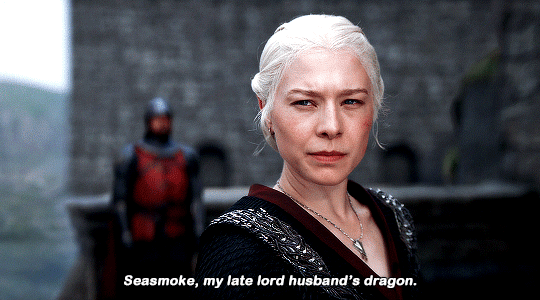

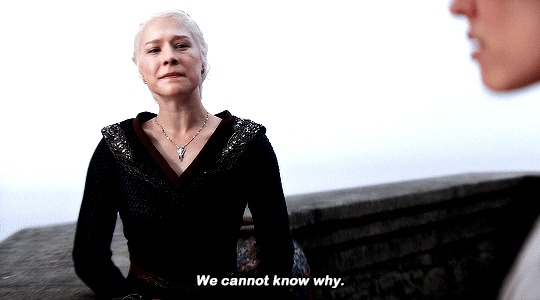
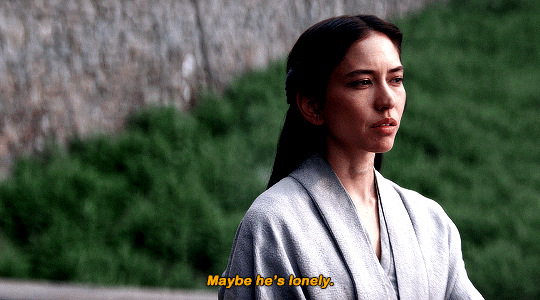

House of the Dragon | 2.03 "The Burning Mill" dir. Geeta Patel
#awwww#i also clued in that it was about rhaenyra at the time#i just couldn't have anticipated mysaria filling that void for her#certainly not in a gay way :p#very sweet#i'm very partial to sincerity so i was pleasantly surprised that it felt sincere - that it seemed intended as such#call me a square but i'd been dreading that it would be merely manipulative - i loathe how often that's the only angle of female queerness#we'll see how it develops - for now there's conflicting creative commentary about it#obviously on a tragic dramatic show like this it is always gonna be complex - just wondering what the narrative Function will be#going from a spur of the moment earnest welling up of desire and connection - enriching interiority for both characters#- to a lead writer saying it's cause to Complicate things and that it's 'gonna be a problem'... hm hm hm we'll see#house of the dragon
3K notes
·
View notes
Text
A Gay Girl's Guide to Takarazuka

L to R: Sagiri Seina, Ouki Kaname, Amami Yuuki, Asumi Rio, Wao Youka, Asaji Saki, Shiraki Ayaka
If you’re queer and into theatre or Japanese media, chances are that you will have heard of all-female theatre company Takarazuka Revue… but it’s also equally likely that you won’t have checked out anything of theirs. For those who are curious but were intimidated by its over 100 years of history, or who just want a quick primer to ease in, click below!
1. Why get into Takarazuka?
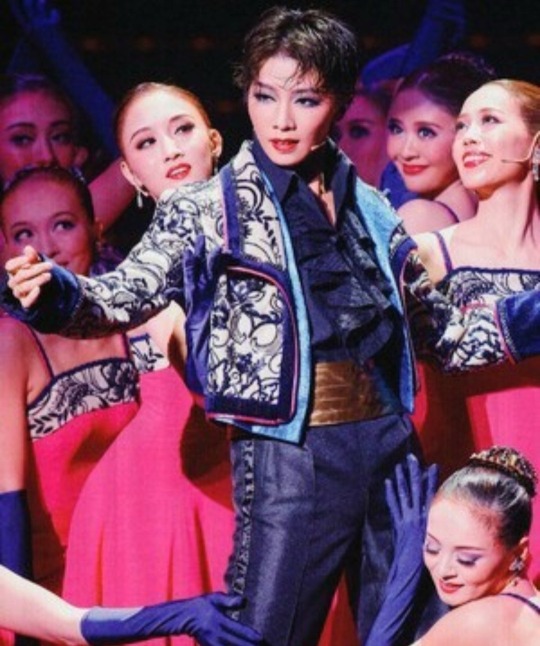

L to R: Rei Makoto in Tiara Azul (2024), Yuzuka Rei
For those into androgynous women
As you probably already know, Takarazuka's big selling point is that it's an all-female theatre company where the male characters are played by women. The actresses are expected to continue presenting that way off-stage, which in practice means a lot of handsome women with short hair in binders and men's clothing... Why that might appeal to people who are into androgynous women (or GNC/enby folks) is pretty obvious.
Reality Check:
Sadly, after "graduation" (i.e. leaving Takarazuka), nearly all such actresses will transition into feminine presentation and take on female roles. It's similar to the "lesbian glasshouse" idea in Class S yuri, but for gender non-conformity. That said, there are some notable counter-examples: Shion Yuu and Nanami Hiroki have basically refused to change their presentation after graduating (the latter still frequently plays male characters in both anime and stage productions), and things are more relaxed lower down the rungs too.


L to R: Wao Youka & Hanafusa Mari, Sagiri Seina & Sakihi Miyu
For those into butch/femme pairs
Just as roughly half of Takarazuka's actresses specialise in male roles (otokoyaku/男役), there is another half specialising in female roles (musumeyaku/娘役). On top of that, Takarazuka is split into five different troupes, and for any given production, the male lead and female lead are automatically assigned to that troupe's "top star" (leading otokoyaku) and "top musumeyaku" (leading musumeyaku) - the "top combi".
Unlike leading pairs in other theatrical traditions, the "top combi" concept extends to them being marketed as a pair in interviews, magazine features, TV programmes, etc. Just watch the mini TV special where Sagiri Seina and Sakihi Miyu visit Tokyo Skytree and Sumida Aquarium-- it's basically a date, and is described as such by the commentating TV announcer. Likewise, Wao Youka and Hanafusa Mari were interviewed about being a "golden combi" by women's magazine Fujin Kouron (though to be fair this was after they had, improbably, managed to win a Kikuta Kazuo Theatre Award - an award for individuals - jointly, for their "splendid performance as a combi" in 2004's Boxman).
Taken to its extreme, there have been cases where the Japanese public have been convinced that a top combi was dating, as with the immensely popular 1980's pair Daichi Mao and Kuroki Hitomi... It's no wonder that the actresses themselves frequently describe it as being like an arranged marriage.
Separately, due to certain reasons, it's practically part of the job description for top musumeyaku to adore their top star partners. This, in theory, inadvertently creates a safe space for any top musumeyaku who could be gay for their stage partners... Just to illustrate, during her graduation speech, Hinami Fuu repeatedly referred to her feelings for her top star partner Hokushou Kairi as koi (恋), a word specifically denoting romantic love, and nobody blinked an eye.
Reality Check:
Due to conservative attitudes in both Japan and Takarazuka itself, most actresses go on to marry men, including many of those named above. Vanishingly few are publically out, though former otokoyaku Higashi Koyuki (stage name Aura Maki) is a queer activist and was one half of the first same-sex couple to be married in Japan, and another former otokoyaku, Misuzu Aki, has been living with her female partner in Europe for years. Just, well, don't forget that being married to a man isn't necessarily evidence of heterosexuality.

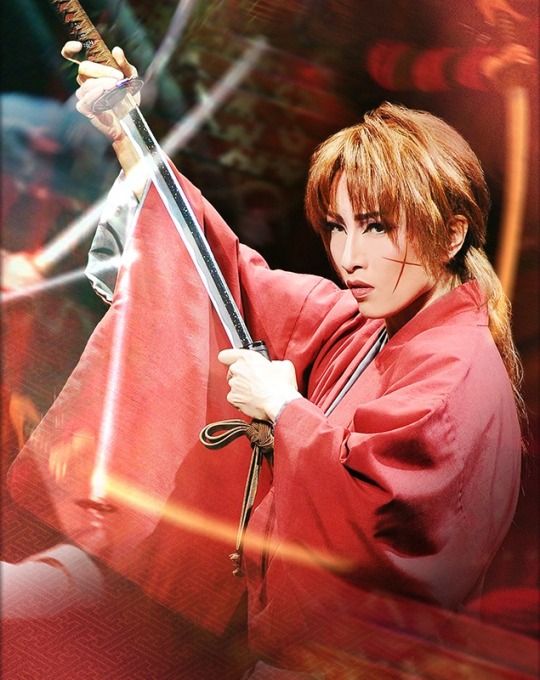
L to R: Asumi Rio in The Poe Clan (2018), Sagiri Seina in Rurouni Kenshin (2016)
For lovers of anime and manga
Takarazuka is probably best-known as the inspiration behind Revolutionary Girl Utena, Revue Starlight, Kageki Shoujo, and Sailor Moon’s Haruka and Michiru, but did you know that it also inspired seminal works featuring androgynous female leads such as Princess Knight? If you enjoy “prince-type” characters in yuri, you’ve got them to thank
Apart from inspiring anime and manga, Takarazuka also does quite a few animanga adaptations itself! Most famous are their Rose of Versailles musicals, but other popular adaptations include Ace Attorney, Rurouni Kenshin, Lupin III, Boys Over Flowers, and Hagio Moto’s bishounen vampire vehicle The Poe Clan. They’re also doing a Castlevania musical this year!

Wao Youka & Hanafusa Mari in Phantom (2004)
For the theatre nerds
Female Phantom of the Opera, duh
Jokes aside, Takarazuka’s unique position in the theatre world can't be overstated. As a rule, all-female productions are either smaller-scale, one-offs dependent on the work, or part of a theatrical tradition completely separate to Western-style plays or musicals (hello, Chinese Yue opera). Takarazuka is the exception: it offers productions comparable in size and scale (and budget) to the largest West End and Broadway musicals - it just so happens that it's all-female.
If the all-female aspect doesn’t excite you then why are you here, then let me emphasise again: Takarazuka is totally worth checking out as a production company in its own right. It is very much a part of the broader Japanese musical industry, and one of its powerhouses at that. Just take a look at some of these clips from past productions (all around 5 mins or less):
(a) Maeda Keiji - a musical loosely inspired by real-life samurai Maeda Keiji; features an uncannily convincing horse performed by two people in costume which needs to be seen to be believed (b) Ephemeral Love - a period piece about the doomed love between Prince Rudolph of the Hapsburgs and his lover Marie Vetsera (c) The Man Who Never Sleeps - a biographical musical about Napoleon Bonaparte (d) Casino Royale - an adaptation of the 2006 James Bond movie of the same name (e) BADDY - an off-the-wall sci-fi comedy featuring loads of velvet suits, silly shellfish outfits, and queerness.

Wao Youka and Hanafusa Mari in Dracula (2011)
2. Random Queer-ish Trivia
It's pretty common for former otokoyaku to be cast in WLW roles: Sena Jun headlined the 2018 Japanese production of Fun Home, Otozuki Kei cameoed as a lesbian escort in 2022 LGBTQ-themed J-drama Kojinsa Arimasu, and Seto Kazuya played the owner of a lesbian bar in 2024 yuri J-drama Ayaka is in Love with Hiroko. (Incidentally, Sal Jiang, the original creator of Ayaka is in Love with Hiroko, has mentioned being a fan of Sena Jun when she was younger)
Otokoyaku are sometimes mistaken for men, with amusing results: Yuzuka Rei was thought to be a “host” by a passer-by while talking to her fans, and Houshou Dai has mentioned being hit on by a woman before. But the prize goes to Todoroki Yuu, who like many women once had to rebuff unwanted advances from a man—except in her case, he thought that she was a guy
Before entering Takarazuka, Sou Kazuho – eventual Snow Troupe top star – went to a co-ed school and had long hair. To her confusion, this didn’t stop her classmates from asking her to play a male character (possibly the male lead, IIRC) in the school play. They saw her as an otokoyaku even before she did!
Continuing with the high school theme, former Cosmos Troupe top star Wao Youka has boasted about how in her high school days, she received more Valentine’s chocolates than her brother, and in fact second-most out of her year. Important note: she went to a girls’ school
Speaking of Wao Youka, her 2011 Dracula (see photo above) - from @cryoverkiltmilk's “Cunt Dykecula” post - wasn't actually a Takarazuka production! Since Wao was acquainted with and later married its composer Frank Wildhorn, some assume he was the one to cast her, and that Hanafusa Mari was brought in due to being her old stage partner. But Wildhorn had wanted Wao to play the female lead. It was she who insisted on Dracula. And Hanafusa wasn't just a third party... she had been Wao's manager since 2007, having retired from the stage after graduating and only just returned with 2010's Dietrich. (She played Edith Piaf, legendary chanson singer and “very good friend” of bisexual icon Marlene Dietrich, played by Wao.) Dracula was the swan song for their partnership, with Hanafusa going on to conquer the Japanese musical industry as she had Takarazuka-- but it marked the first, and so far only, time a top combi performed as romantic partners after graduating.
On a separate note, renowned queer photographer Leslie Kee has been responsible for taking the cover portraits for Takarazuka's offical monthly publication Kageki (歌劇) since 2010. You should definitely check out his ongoing "Out in Asia" project – he's taken literally thousands of photos of out queer people in Japan, Singapore, and Taiwan in a bid to raise visibility
Lastly, in November 2015, Takarazuka City became the first Japanese city outside of Tokyo to announce its support for same-sex partnerships… though this may of course be a total coincidence.
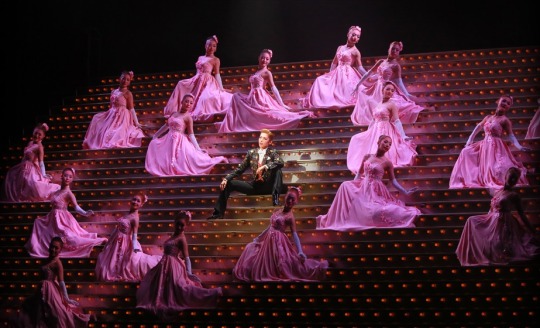
Flower Troupe in Takarazuka Fantasia (2015 Taiwan tour)
3. Where to Start?
Nearly all Takarazuka shows since the 1990's are available on DVD (earlier ones are on VHS), and these recordings are very well done - they have great video and audio quality, are well-edited, and use a large number of camera angles
They do livestreams and live broadcasts of performances as well! You can watch a livestream from your mobile or PC by spoofing your location. For a more communal experience, if you're in Japan, Taiwan, or Hong Kong, you can catch live broadcasts of Grand Theatre performances at a local cinema
VODs of selected productions are available on various platforms, including Amazon Japan, though this still requires location spoofing. If you're actually living in Japan, you can also consider subscribing to Takarazuka's official TV channel (yes, that's a thing) Sky Stage - they do a lot of reruns of past performances
With that done, here are several recommendations if none of the productions mentioned throughout the post caught your eye!
(a) Elisabeth - Michael Kunze and Sylvester Levay's musical about Empress Elisabeth ("Sisi") of Austria and the fall of the Hapsburg Empire, featuring an (inevitably very sexy) personification of Death and fantastic music. Takarazuka has done many, many productions of this, so just search them and pick whichever looks most appealing - but you won't go wrong with the 2014 Flower Troupe production, which has a very strong cast and a more refined version of the staging
(b) Phantom - Arthur Kopit and Maury Yeston's adaptation of Phantom of the Opera. Though obviously not the ALW version, the music is actually pretty great and Takarazuka goes all-out on the costumes and stage magic. All the productions are wonderful, but my favourite is the original 2004 version (which is also the one which went viral on Tumblr before - thanks, @wheel-of-fish!)
(c) Rose of Versailles - no list would be complete without Takarazuka's representative work, buuut I wouldn't necessarily recommend starting here if you're looking for a typical musical experience. There are loads of productions to choose from - note that these are split between a version focused on protagonist Oscar, and another focused on Marie Antoinette and her lover Fersen - but the 1991 Moon Troupe production is my personal pick
(d) Casanova - a light-hearted romp in which Casanova is reimagined as a charming playboy who falls for the feminist-minded daughter of Venice's mayor... only, she doesn't know his real identity. The very catchy music was commissioned from Dove Attia, the producer behind French musicals Mozart, l'opera Rock and 1789: Les Amants de la Bastille. Check out the performance digest here!
(e) Shinjuu: Koi no Yamatoji - Takarazuka puts Chikamatsu Monzaemon's tale of the doomed love between a commoner and a courtesan to a classic rock score (see this clip!). An Edo-era work that doesn't just focus on samurai and nobility, this romantic tragedy offers a grounded look at the social pressures of the time. (Though if you do want to watch something focusing on Japanese nobility, I highly recommend Takarazuka original and guaranteed tearjerker Hoshiai Hitoyo.) There are quite a few productions of this, but I've only watched the 2014 Snow Troupe one, which was very good.
Thanks so much for reading! Please feel free to DM me or send an ask if you have any questions~ I definitely want to do a follow-up post on musumeyaku, and maybe delve into Wao and Hanafusa's history (it's messy, but fascinating)... but we'll see!
#takarazuka#musicals#theatre#elisabeth das musical#phantom of the opera#rose of versailles#butch#yuri#queer#ayaka is in love with hiroko#wlw recommendations#takarazuka revue#musicaltheatre
663 notes
·
View notes
Text
Will we ever get anything quite like Code Geass again?
I don't think it's possible.
Code Geass is Japanese nationalist propaganda disguised as a global political drama, disguised as a military mecha show, disguised as yaoibait, disguised as a teen melodrama, disguised as a high school romcom, disguised as a Pizza Hut commercial...
...except those layers aren't layers at all, but are instead comingled in a giant snake ball of insanity.
The lead writer, Ichirō Ōkouchi, only ever worked as an episode writer for other shows prior to Code Geass, and never took the helm of an anime series ever again. And it shows. [EDIT: Several people have pointed out his other lead writing credits to me. So I misread Wikipedia—sue me. I maintain that this guy is a better episode writer than he is a lead writer.]
The minute-to-minute pacing is impeccable from a mechanical standpoint, with tension and stakes rising to ever-higher peaks, balanced out by the slow simmers of the b-plot and c-plot. It keeps the viewer on the edge of their seat at all times. Meanwhile, the large-scale plot is the most off-the-wall middle school nonsense I've ever seen, continually surprising the viewer by pulling twists too dumb to have ever have been on their radar—and therefore more effective in terms of raw shock value.
"Greenlight it!" was the mantra of this anime's production. It must have been. It has, in no particular order, all of the following:
Character designs from CLAMP, the foremost yaoi/BL group in Japan at the time—for characters who are only queer insofar as they can bait the audience, and only straight insofar as they can be more misogynist to the female cast.
Speaking of the female cast, hoo boy the fanservice. We've all seen anime girls breast boobily, with many cases more egregious than Code Geass, but there's something special about it happening immediately after—or sometimes in the middle of!—scenes of military conflict and ethnic cleansing.
Pizza Hut product placement everywhere, in every conceivable situation. High-speed chases, light slice-of-life scenes, intimate character moments, all of it. Gotta have Pizza Hut.
The anime-only Pizza Hut mascot, Cheese-kun. He wears a fedora.
The most hilarious approximations of European names—which I would love to see more often, frankly. Names like, I dunno, "Count Schnitzelgrübe zi Blanquezzio."
A depiction of China that is wholly removed from any modern reality, with red-and-gold pagodas, ornamental robes, scheming eunuchs, and a brainwashed child empress. There's a character named General Tsao, like the chicken.
Inappropriate free-form jazz in the soundtrack, intruding at the most unexpected times.
A secret cabal not unlike the Illuminati, run by an immortal shota with magic powers, holding influence all across the world, at the highest levels of government. They matter for approximately three episodes.
An unexpected insert scene of a schoolgirl using the corner of a table to masturbate. She's doing it to thoughts of her crush, the princess Euphemia—because she believes Euphemia to be as racist as she herself is, and that gets her off. This interrupts an unrelated scene of our protagonist faction planning their next move, which then resumes as if uninterrupted.
Said schoolgirl, in a fit of hysteria, threatens to detonate a worse-than-nuclear bomb in the middle of her school. She then goes on to develop an even more destructive version of that bomb, and become a war criminal, in a chain of cause-and-effect stemming from the moment she finds out that Euphemia wasn't actually that racist.
A character called "the Earl of Pudding."
A premise that asks us to believe that the name Lelouch is normal enough that he didn't need to change it when he went into hiding as an ordinary civilian. "No, that's not Prince Strimbleford von Vanquish! That's our classmate, Strimbleford Smith."
The collective unconscious, a la Carl Jung, within which the protagonist fights his villainous father for control over the fate of humankind. After this is over, the anime just keeps going for about ten more episodes.
An episode in which a mech tosses a giant pizza.
A gay yandere sleeper agent who can manipulate the perception of time.
Chess being played very badly, even to the untrained eye. Lelouch frequently checkmates his opponent by moving his king. This goes hand-in-hand with the anime's crock of bad chess symbolism.
A fictional drug that can most succinctly be described as "nostalgia heroin."
Roller-skating mecha in knightly armor, and some of the most sickass mecha fight choreography that I've seen.
I could go on and on, but I think you get the picture. This anime is what the average Westerner in 2006 thought anime was, and it was made in a confluence of factors that cannot be replicated. I've never had so much fun watching something that I found so... insulting. Repugnant. Ridiculous. Baffling. I love it sincerely.
Catch me cosplaying Lloyd Asplund at a con sometime, or maybe even the big gay loser himself, Lelouch vi Britannia.
#code geass#anime#lelouch vi britannia#rolo lamperouge#nina einstein#kallen kozuki#lelouch lamperouge#clamp manga#lloyd asplund
5K notes
·
View notes
Text
when I say riverdale is genius I truly mean it because what other show's creator would perpetuate a twenty year long revenge scheme over a cease and desist he received for writing a queer play (which included serial killers, of course) about the main character of a decades old comics series he would later acquire the intellectual property rights to that ultimately culminates in making every single character from said comics series, no matter how minor, coming out as queer in some capacity, INCLUDING having the two female leads fall in love in the shows final season. none of you understand true art and it shows
4K notes
·
View notes
Text

Alright. It is time. Buckle up.
Why you should be watching Dead Boy Detectives: the targeted-specifically-at my-readers edition.
Meet the leads, our two ghost boys:
Edwin Payne: Fussy, repressed intellectual type from the Edwardian era. Exceedingly gay for his partner and best friend. Tortured in hell for seventy years on a technicality because he was ritually sacrificed as a prank gone wrong. Endearingly awful at people and dealing with emotions or his own wants.
Charles Rowland: Impulsive, people-pleasing wildcard from the 80s. Heart eyes 24/7 at his best friend but has zero self-awareness. Badly abused by his asshole of a father. Beaten to death because he saved a kid from bullies. Endearingly awful at sorting his own emotions or talking about his problems.
Some highlights:
/slaps hood you can fit so much trauma in these two
Both leads get sobbing breakdowns that happen on screen. The actors are incredible at crying
Both leads get much-needed hugs
The absolute devotion between the two of them. The shared history that lives in their dialogue and how they work together like people who have been each other's Most Important Person for literal decades
I mean, I'm talking in-canon Orpheus and Eurydice reference level of devotion here
The protective way Charles puts himself physically between Edwin and damn near every threat in the show
They're just fun together. Their interactions and banter and how they work as a team is a delight
Their shared plot arc literally involves them learning to talk to each other and communicate more so that they can be there for one another about their respective issues
The symbolism. God. They are metaphorically and literally one another's light in the darkness
But what about stuff that isn't the main duo? Just wait, there's more:
This show is unabashedly, unapologetically queer. It's there in the text and the subtext. The whole show lives and breathes it
So many good, complex, well-written female characters. The Bechdel test gets blown straight out of the water in episode one and they never look back. Headstrong amnesiac psychic learning to be a better person! Quirky meta commentary matchmaker! Cynical lesbian butcher! Delightfully sadistic witch! They are all amazing.
[audience voice] But I'm here for the hurt/comfort. How can I whump ghosts? Worry not, my friends. Canon has you covered. Not only are there ways, there are ways that happen on-screen. The hurt/comfort and rescue are also on-screen. Yes, it is amazing
Absolute chaos, really cool supernatural cases and creatures, a surprising amount of humor, charming writing, and a cast that absolutely nails it on the acting and chemistry
There is an extremely suggestive trickster type who is also the king of cats. He's a cat in human form. He hits on Edwin nonstop. Charles gets blisteringly jealous
All of the leads have well-thought-through, fully developed, emotional character arcs. They're all messy and flawed and sometimes lash out in their pain, but at turns can be incredibly supportive and kind and loyal
A character who is a crow who is also a boy, who is tortured by his witch/creator and also is crushing hard on one of the leads
There are so many incredible details in the setting, costume choices, prop decisions, etc. that you only catch after you know what it's laying the groundwork for. The level of care that went into this show is phenomenal
It's only eight episodes. The time investment barrier to entry could not possibly be lower
Anyway, tl;dr, if any of this sounds appealing to you, you should give this show a watch.
Dead Boy Detectives is well worth your time. It's easily my favorite show in years.
#dead boy detectives#dbda#dbda spoilers#edwin payne#charles rowland#payneland#whump#hurt/comfort#lgbtqia#netflix
994 notes
·
View notes
Text
Fangs of Fortune (Bai Ze Ling): perfect on pure aesthetics alone, but also it will tear your heart out while being very gay.

I was lured in to this show by Tumblr gifsets and friends on Bluesky talking about how queer and poly this show is. I'm old and I've been in fandom more than half my life. I know how to read queer subtext. I'm also pretty well versed in cdramas, so again, I know how to read subtext. So I went into this ready to, well, read the subtext.

But no this show is just puts the queer it right there in the text. The vague information we have about Chinese censorship repeatedly left me asking, 'wait how are they getting away with this?' Like some of these jokes and implications are just so blatant it seems incredible this show ever made it to being broadcast. It just feels very much like queer media made for queer people even if t's more subtle than something western like Queer as Folk.
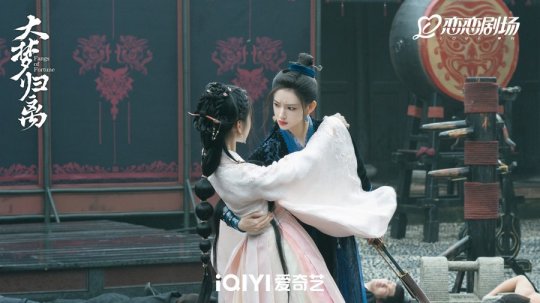
Even without the heavy coloring of gay this show is incredible and so much more than I expected from the title and the promo. The premise is essentially the death of the goddess, who governed relations between humans and demons, leads to an influx of demons in the human world. This brings together the goddess's disciple, Wen Xiao--seeking to restore the goddess's power. WX's childhood sweetheart, Zhuo Yichen--seeking to restore the demon-hunting bureau after the powerful demon Zhu Yan killed his father and brother. It opens on Zhu Yan, in human disguise as as Zhao Yuanzhou, volunteering to help the imperial court restore the demon-hunting bureau to quell the chaos. They are joined by Pei Sijing, a retired female general from the rival demon hunting sect, and a very young doctor (and comic relief) named Bai Jiu. It starts off as a sort of monster-of-the-week with a grim Scooby gang doing detective work and fighting monsters. Each major demon has a mini arc that relates to the larger case (restoring the power of the goddess to balance the realms), and they are repeatedly blocked by either the demons or the rival demon hunting sect. Each mini arc also acts as a mirror or parallel story to slowly revealed backstory of all the main characters as well. In true cdrama fashion it's a mix of adventure, intense emotional drama, romance, and comedy. And queer and poly jokes and romance. It also has a kind of manga vibe in the way the comedy is woven into the more serious story, and in the fantastical depiction of the characters and how the story unfolds.


It is also just insanely beautiful. Every single shot is lovely. The costumes, make up, and hair are incredible. The casting director made all the major demons inhumanly beautiful. The sets are spectacular. The effects are nicely done. Every bit of has the vague surreality of a fairytale. The perfection of each shot ads to the manga vibe, as if we're seeing each critical storytelling panel come alive. There's recurring water-based special effects that are just gorgeous. Based on aesthetics alone this show would be worth watching to me. That it is combined with a complex, very emotional story is a spectacular gift to the watcher. A lot of the negative reviews of this complain about the staginess or that it's overly contrived in how each scene is shot. But I think it's gorgeous, works perfectly with the storytelling, and if we criticize art on whether it achieves the goal it intended then this show is doing exactly and perfectly what it means to do and doing it beautifully.
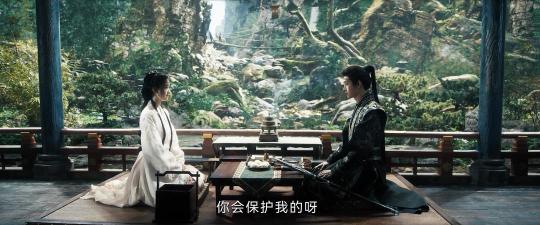

Additionally the acting is also very good, but Neo Hou is the stand out for sure. I enjoyed him in Back from the Brink, especially the later part of the story, but in Fangs of Fortune he's transformed, utterly embodying the role, the way Dylan Wang is Dongfang Qingcang in Love Between Fairy and Devil. Neo Hou has the right look, a slightly uncanny beauty perfect for a gorgeous immortal not of this world. The show does incredible things with his styling between the various looks and personas the role requires. But in acting he somehow manages to utterly transform his face and demeanor to manifest each aspect of the character as story demands changes from him.
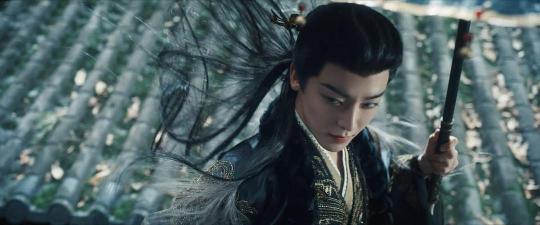
There is a lot of crying in this drama. Like early on I joked that there was going to be a character crying a single perfect tear in every ep. Lol nope. Multiple single perfect tears per ep and many outright full on sobbing scenes. This show is just waiting to rip your heart out and you see it right from the beginning. But it was such sweet pain all the way through. Just a truly engaging and utterly wrenching set of intertwined stories.

My only criticism is that the pacing falls apart in the last 3 episodes. But overall the story is solid through the end, though like so many cdramas, it's saved by the epilogue.
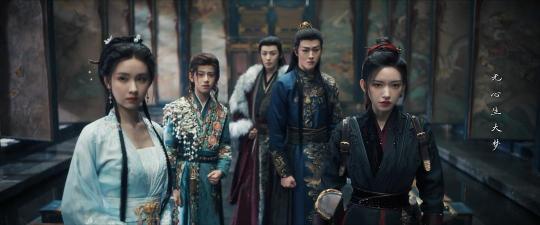
You should absolutely watch it if you want the chaotic bi polycule (it's her, her girlfriend, her boyfriend, her boyfriend's boyfriend who is also her boyfriend, their two idiot sons, and her boyfriend's ex-who is also eventually sort of his boyfriend again), or if you want your heart torn out and stomped on. Or even if you just like really gorgeous cinematic things. Also if you watch, please don't skip the ending credits, as they change as the arcs change, and the radiant joy Tian Jiarui has as he dances is an excellent antidote to the emotions of each episode.

#Fangs of Fortune#大梦归离#Bai Ze Ling#cdrama#Hou Minghao#Neo Hou#侯明昊#Zhao Yuanzhou#Chen Duling#Wen Xiao#Tian Jia Rui#Zhuo Yichen#Cheng Xiao#Pei Sijing#Lin Ziye#Bai Jiu#Yan An#Li Lun#ab-HMH-mine#ab-reviews#it's really the xianxia polycule of dreams#which I didn't know to hope for until this show spoonfed it to me
257 notes
·
View notes
Text
So it is with Florence Hines, a Black singer and drag king who got her start on the stage sometime around 1891, when she began to receive particular notice for her performances with Sam T. Jack’s Creole Burlesque. When the show came to Paterson, NJ, on November 23, 1891, “hundreds were turned away from the doorway” before the Creole Burlesque was even scheduled to take the stage, according to the Paterson Daily Caller. In their review, they called out Hines in particular for being an “excellent male impersonator.” The Creole Burlesque was a standard minstrel show, featuring all Black performers, led by a white manager, giving skits, songs, and scenes that featured standard variety acts (everything from clog dancing to drag) set in a pre-Civil War Southern plantation fantasy. But within a few years, Sam T. Jack would launch The Creole Show, an important milestone in Black performance in America. For the first time, an all-Black revue was presented as a modern, staged performance — not as an “authentic” recreation of Black life. According to Whiting Up, a history of white face entertainment by Black theater historian Marvin McAllister, The Creole Show was “a major outlet for Black artists interested in… developing a comedic tradition that was racially grounded but not riddled with stereotyping.” In another important departure from tradition, instead of hiring a man to play the traditional lead role of interlocutor or master of ceremonies, Sam T. Jack hired Florence Hines. As a drag king, Hines performed a routine that made mock of the “dandy” — flashy, modern, young men who drank and dated openly, and wore the latest clothes. One of her most famous numbers was “Hi Waiter! A Dozen More Bottles,” whose first verse went: Lovely woman was made to be loved, To be fondled and courted and kissed; And the fellows who’ve never made love to a girl, Well they don’t know what fun they have missed. I’m a fellow, who’s up on the times, Just the boy for a lark or a spree There’s a chap that’s dead stuck on women and wine, You can bet your old boots that it’s me. Many white drag kings of the day also performed this song, and similar dandy characters. For these performers, the dandy was a way to needle the men in the audience. But for Black performers, taking on a dandy role was also a way of resisting degraded depictions of Black people that were common on stage at the time. As Kathleen B. Casey wrote in The Prettiest Girl on the Stage is a Man, “when worn by a Black performer, the tuxedo with tails, cane, cape and a top hat countered the image of the ragged, shoeless plantation slave.” Thus, Hines made a natural choice for a show that wanted to show an entirely new kind of Black performance. By 1904, The Indianapolis Freeman would report that Hines “commanded the largest salary paid to a colored female performer.” In their book, Out of Sight: The Rise of African American Popular Music, 1889-1895, Lynn Abott and Doug Seroff wrote that “Hines’s male impersonations provided the standard against which African American comediennes were compared for decades.”
343 notes
·
View notes
Note
It’s canon Mitsuba’s gay?
I’m gonna use this as an excuse to yap because Mitsuba’s queercoding is either weirdly downplayed by fans or used solely for BL shipping purposes so I want to talk about it through the lens of what it means for his character, role in the story, and relationship with Kou
Yes, Mitsuba is canonically gay
Things don’t have to be explicitly stated in order to be canon, subtext is a major part of media analysis. This is something a lot of fans miss which leads to a misunderstanding of the source material. I do have some credentials for this, I’ve taken two undergrad college literature classes in which the subject of queercoding did come up multiple times. Meaning analyzing queercoding has literally gone towards my degree so I feel like my opinion holds some weight (not as much as that of an actual English major but yk I assume I’ve had more education on it than the general TBHK fandom)
There are multiple ways to queercode a character, sometimes it can be as simple as feminizing a man or masculinizing a woman. Though that method might be a bit outdated nowadays with gender roles becoming less strict, it’s still worth keeping in mind when analyzing queer characters. Another way is through romantically colored scenes with characters of the same sex, or by having them hint at disinterest in the opposite sex. Mitsuba checks off all three of these boxes and then some
First off, Mitsuba is attracted to men. This is made extremely obvious through his relationship with Kou but I’m gonna explain it anyways because unfortunately I’ve seen a lot of fans say they’re just platonic
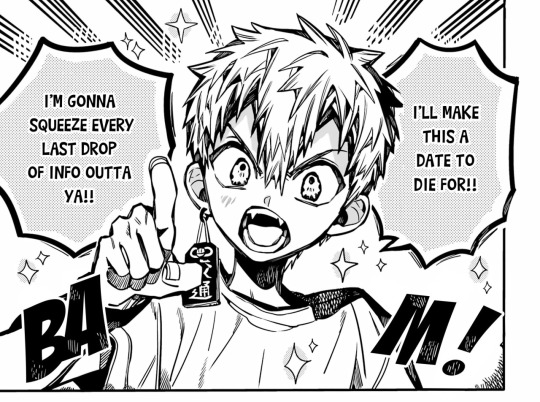
Mitsuba and Kou went on a date. When this is brought up, fans typically jump to the excuse of “but Kou said it wasn’t a date,” which is where my American Lit class is going to come in handy. One of the major things we learned is that authors have to understand that everything they write has some sort of real world connotation. If you write a scene with a doctor, you have to understand that your readers already have preconceived notions of what doctors represent. You can choose to either lean into that or subvert it, but you have to be aware that as soon as a doctor enters the scene, readers have already made assumptions about that character
The word “date” is clearly being used in a romantic context here. When Kou texts his friends and brother about it, they all assume he’s talking about a romantic date. While in the actual context of the scene, Mitsuba and Kou aren’t quite ready to use such a strong label yet, the romantic wording here is still very intentional. AidaIro would not have labeled this moment as a date if they didn’t want readers to view it in a romantic light, because they understand that their readers are going to associate dates with romance. Japanese censorship is really strict, it’s hard to publish stories with explicitly queer characters unless the series is labeled as a BL or GL. And so Japanese manga writers often have to find roundabout ways to express that characters are gay without outright stating it- such as suggesting that they’re going on a date with a character of the same sex
In the printed volume for Vol.20, there’s an editor’s note that mentions that when Kou and Mitsuba are making plans to hang out at the school festival, it holds a romantic implication for the Japanese audience. Cultural differences are important to keep in mind, to western fans this scene might not raise any eyebrows but for its primary audience, it is confirmation that Mitsuba and Kou are romantic. I also find it interesting that the editor felt this context was important enough to warrant clarification

And frankly, their relationship doesn’t make a lot of sense if it’s solely platonic. Male friendship is something TBHK writes very realistically, the male characters aren’t as touchy-feely with their friends as they are with their female love interests. Yokoo and Satou don’t directly ask Kou how he’s feeling when they notice he’s upset, instead they give him a task to distract him- similar to how men in real life cheer their friends up through quality time rather than talking through their emotions like women do (not every man ofc but a good majority of them). When Teru is down, Akane doesn’t hold him and reassure him the way he does with Aoi. There are no grand declarations of ultimate “friendship” the way you see in fan servicy series like Haikyuu. Instead, he used his and Teru’s rivalry to indirectly motivate him to get his head back in the game. When Hanako is sad, Kou cheers him up by making donuts for him and then giving them to Nene so she can pretend she’s the one who made them. This is a very healthy portrayal of male friendship, and Mitsuba and Kou are nothing like this

Mitsuba and Kou both cry and vent to each other multiple times (the Mitsuba Arc, the Picture Perfect Arc, the Nightlife Arc), and instead of comforting each other indirectly they do things like offering to die for each other. You would never see Akane offer to die to make Teru feel better, nor would you Aoi and Nene or Kou and Hanako. It stands out so much from other friendships in the series, even Kou’s friendships with other characters. That is a conscious writing decision, AidaIro make a point to show Mitsuba as an exception for Kou. It’s worth noting that in the same chapter where Yokoo and Satou cheer Kou up indirectly, Mitsuba attempts to directly have him talk about his feelings


They’re also incredibly possessive over one another, in a way friends usually aren’t. When Kou was in the Red House, he was shown his greatest desires, and Mitsuba appeared in one of these. Kou said he knew Mitsuba would appear, which is interesting because at that point he had already picked up on the house showing him what he wanted. But what does he want? He wants Mitsuba to rely on him entirely, to be completely useless without him. He wants Mitsuba to be “no good without him,” to need him so badly that he begs him to die so they can be together. I’m not exaggerating, these are lines pulled straight from the chapter (paraphrased but still). Later on in the Nightlife arc, Kou breaks down when he discovers Mitsuba has been relying on Tsukasa for life-saving help. As for Mitsuba, he wants to die by Kou’s hands. He says it wouldn’t be satisfying if anyone else killed him, and that he would be happy if Kou were to be the last person he spent time with before he died. He tries to trap Kou in a picture perfect world just like Hanako does with Nene, because he wants to live a normal life with him. It’s also shown in one of the extras that Mitsuba cries when Kou ignores him

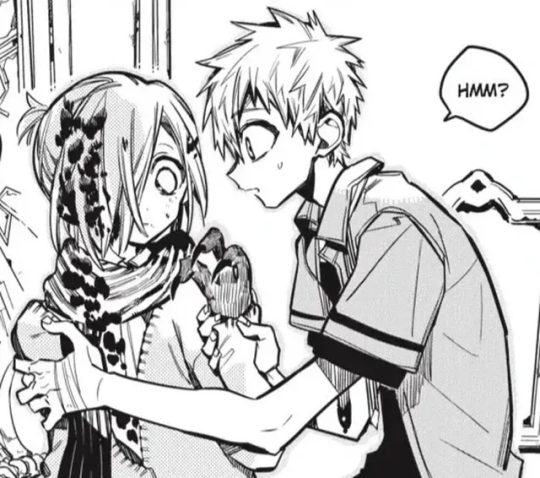
They’re also drawn very romantically, again we don’t see Teru and Akane this intimate with one another unless they’re fighting. We especially don’t see Kou this intimate with anyone other than Mitsuba, and while Mitsuba is sometimes clingy with Tsukasa we certainly never see him posed romantically with a woman. This comes back to authorial intent and real world connotations, AidaIro know that male friends aren’t typically this close, and therefore casual affection like this will be interpreted in a romantic light. We see them hold hands/wrists multiple times too, Kou gives Mitsuba a piggyback ride in one scene, and in ASHK they had a classic “pinned against the wall” page
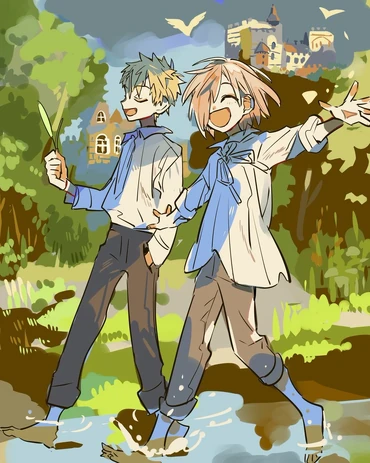
I’ll also mention the AUs, because those indicate a lot about the characters as well. In Hanako-Kun of the Opera, Kou poisoned Mitsuba so he could take him away from the opera house and protect him from Tsukasa. He basically kidnapped him. He also stayed with Mitsuba at the opera house for a seemingly long period of time despite hating opera. Aaaaand they’re childhood best friends in this au and Kou took care of Mitsuba while he was sick
Then there’s the Ghost Hotel, where Kou is a werewolf who takes bites out of mummy Mitsuba during full moons. Despite this, the two appear to be friends and Mitsuba helps Kou out around the kitchen. Cannibalism is consistently tied to romance throughout TBHK, most notably with Hakubo and Sumire but other romantic pairings have cannibalistic moments or official arts. During the zombie mokke chapter, Nene panicked when Akane tries to eat her because she assumed it would put her in a love triangle with Aoi. So yeah, cannibalism in TBHK is directly tied to romance and we see that with Mitsukou both in canon and in this au. Speaking of which, I’m not even gonna get into the symbolism of Kou holding a heart out to Mitsuba. Connect the dots for yourselves
Now that we’ve got Mitsukou out of the way, let’s talk about Mitsuba’s disinterest in women
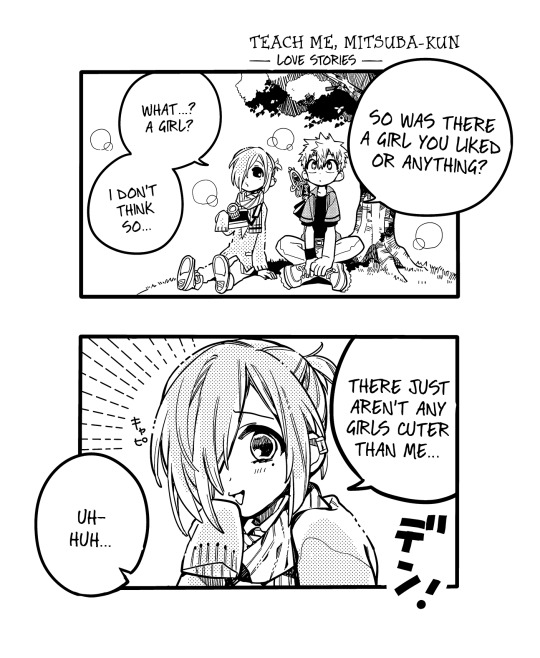
Remember how I said one of the ways queercoding is done is by having a character hint at disinterest in the opposite sex? Yeah, very rarely are we going to see a queercoded male character outright say “I have no attraction to women.” Instead they say they just never saw the appeal in dating, or that they never had time to settle down. In more obvious cases, we have scenes like Reiner from AOT joking that Ymir isn’t all that into guys
I couldn’t find the second scene but there are TWO extras where the subject of Mitsuba’s disinterest in women comes up. C’mon guys I’m trying not to be mean here but you have to be blind, oblivious, or in denial to not pick up on that. Whyyyyy would they mention Mitsuba not having a crush on any girls twice if it weren’t to suggest something about his preference?? Coupled with his appearance (which I’ll get to later) and relationship with Kou, these scenes carry a lot of weight. Even if those other aspects weren’t included, scenes like this would still indicate he has no interest in women (which would make him gay or aroace, though due to his relationship with Kou the aroace thing is kind of ruled out)
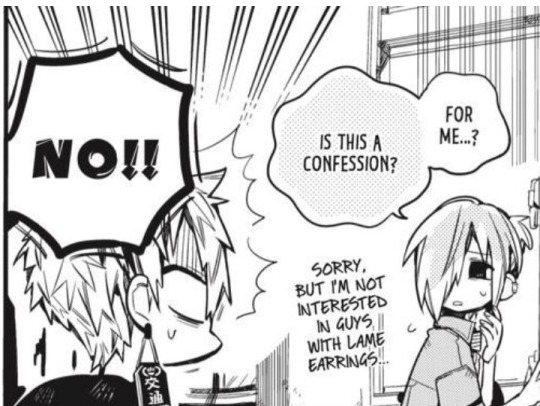
Compare this to a scene where Mitsuba thinks he’s being asked out by a man. He doesn’t say “hmmm nope no guys, I’m cuter than all of them~” he specifically says “I’m not interested in guys with lame earrings.” The way this is worded implies that Mitsuba is discussing a type, though it’s v much a comedic scene and we know from everything else that he absolutely does like guys with lame earrings, it’s still worded in a way that makes him appear queer. If he were straight, they would have had him say he’s not interested in guys at all (like Dazai from Bungou Stray Dogs, John Watson from BBC Sherlock, Finn Hudson from Glee, idk there are a lot of male characters that are explicit straight sorry for the crazy random list). Also note how he teases Kou about it, he knows that Kou is fond of him and doesn’t hesitate to use that against him (like when he was comforting him during the Nightlife arc)
They don’t go overboard with Mitsuba’s disinterest in women because, well, that’s not really necessary. Two scenes is already a lot, and he doesn’t have any romantic relationships with women in canon (even as a crush/a joke scene). It’s rare for TBHK characters to have absolutely no scenes expressing interest in the opposite sex, since the series is partially a romance. But Mitsuba consistently only ever shows interest in one man, and when girls are brought up he’s quick to brush it off. His mom did think Nene was his girlfriend when they met, but this was depicted as a very awkward and comedic scene. Because the premise of Mitsuba having a girlfriend is objectively hilarious
(Due to Sousuke’s young age it’s reasonable to assume he wasn’t out to his mom yet, he’s around the age where most kids are closeted. It’s even possible that Sousuke hadn’t come to terms with his sexuality yet, though it’s still a prevalent part of both his character and No.3’s)

Now let’s move onto appearances. I want to give a quick disclaimer, not all gay men are feminine and not all feminine men are gay. Androgyny is also very common in anime and doesn’t automatically mean a character is gay, but there are cases when it’s used for queercoding. Mitsuba is one of these cases
Mitsuba is a very feminine character, this is addressed as soon as he shows up in the manga. He was bullied for his appearance (and personality), but unlike his personality he never tried to change his feminine appearance. He kept his hair long, continues to wear scarves and cardigans and earrings. No.3 wears these things as well, and I would argue has a more feminine personality since he seems to be more open about his emotions and idk. I struggle to categorize feminine and masculine traits because imo that’s subjective but there are things society deems feminine vs. masculine. The problem is that I really dislike the whole “men are strong and women are emotional” thing but ehhhh I guess I have to talk about it for this. Hmph. But yeah although Mitsuba isn’t exactly the biggest sweetheart ever, he does act somewhat feminine compared to the other male characters (as I’ve said he’s p much the only man in the series who attempts to work through emotional conflicts directly)
Once again we circle back to intent, AidaIro know that a male character dressed in pink with pink eyes and long pink hair is going to raise some eyebrows. Even by androgynous anime standards, it’s a bit much. And good for him, although not all gay men are feminine, some are and that’s also fine. I can’t speak on how well he represents feminine gay men because I’m a lesbian but he does dress similar to some of the feminine gay men I’ve known irl (or slightly less feminine in some cases…I knew this one dude in high school who used to wear corsets to class and he was so badass I hope he’s doing well)
I could get into how Kou is a bit feminized too with the whole housework thing but this ain’t abt him. I will say that Kou is still a very masculine character but despite this his character is feminized in some ways compared to the other men. I’m not really here to discuss whether that’s good or bad, I’m just stating the evidence as it is, you can make your own conclusions as to how you feel about it
So how does being queer impact Mitsuba’s character arc?

When I get around to writing my analyses of all the TBHK characters I WILL be talking more in depth about the queer allegories with Mitsuba’s character but for now I’ll give ya’ll a quick summary. Supernatural characters have been used for years to represent queerness, the same could be said for villains and any character trope that represents a feeling of “otherness.” Sometimes it’s more broad like X-Men, where the superpowered characters are used to represent all types of minorities (though I believe X-Men is more closely tied to race, there are rampant queer themes as well). Then there’s books like Interview with the Vampire that get more specific with it, where Louis denying his “true nature” as a vampire is used as an allegory for him denying his queerness. Well I’m here to tell you that Mitsuba and Louis de Pointe du Lac are in the same boat
Mitsuba differs from the other supernaturals because he desperately tries to hold on to feelings of normalcy. He wants to be a normal human and live a normal human life. He doesn’t want to be othered, to be outcasted from society for something he can’t control. We don’t see Hanako, Tsuchigomori, Mei, or any of the other supernatural characters struggle with this. You could argue that Akane does but his situation is more related to learning to empathize with others than any internal battles within himself. Hanako may have moments of wishing him and Nene could have something more, but that’s more about romance than his identity.
This desire to be “normal” is unique to Mitsuba’s character, and it’s a very queer desire. Being an angsty teenager who hasn’t fully accepted themself yet and hasn’t realized that being queer is not only normal, but a beautiful experience. It’s also so interesting to me that as he’s trying so hard to be normal, it creates a push and pull between him and Kou. He wants to be normal for Kou but he also feels that he’s hurting Kou just by existing, that this could only end bad for him. Oh the inherent guilt of having your first gay crush and feeling like you're corrupting them hist for pining from afar

So, can you ship him with women? Technically you can do anything, shipping isn’t illegal and we all have free will. Should you ship him with women is more subjective, I personally think no!! Queerness is not just a sexuality, it’s an identity that deeply impacts who you are as a person. It shapes your experiences and your view of yourself, and in an allegorical way it has certainly done this for Mitsuba. Yes, bi people are queer as well and this is still true for them, but bisexuality is not Mitsuba’s experience. Mono-attraction exists and that specification is very important to gay men and lesbians. For some people sexuality is fluid and that’s beautiful, but it doesn’t work that way for everyone
Some queer fans don’t care if gay characters are shipped with members of the opposite sex, and they’re entitled to their own opinions. It makes me immensely uncomfortable tho, so please block me if you ship Mitsuba with women. That goes for any ships between canon gay/lesbian characters and the opposite sex. I respect people’s right to have opinions but that doesn’t mean I have to like the opinions themselves, and I don’t have to engage with anything that makes me uneasy. That goes for all of you btw, never let people convince you that you have to put up with shit you hate on the internet lmao, this is not real life babes. Block and move on
TL;DR
Mitsuba is too gay to function
#ask#ask me anything#tbhk#toilet bound hanako kun#jibaku shounen hanako kun#jshk#analysis#queer coding#mitsukou#sousuke mitsuba#kou minamoto#soukou#kousuke#queer analysis#gay#mlm
256 notes
·
View notes
Text
First episode of ‘Agatha All Along’ down. Aubrey Plaza is playing a character that’s… perfect for Aubrey Plaza. Creepy but captivating and very very queer. No surprise there. Katheryn Hahn, on the other hand, is playing a character that reminds me of a young Wynonna Earp. Not just her appearance, but her charisma too. Her character humour - snappy one-liners that you might have to play back to catch in their full context and to be able to laugh along unless you’re as quick-witted as the writer and actor is - to which I’m definitely not. There’s still dialogue and references from the show ‘Wynonna Earp’ that I don’t get to this day no matter how many times I hear them. It’s just far beyond me to catch on to the tag-team comedic duo of Emily Andras and Melanie Scrofano. But yeah, there’s definitely a lot of that going on. All this clever quick-witted humour with this Agatha character that I’m picking up on right off the bat makes this character seem much more worldly and dynamic than I’m getting from the story/plot at the moment.
That’s good. I like what I’m seeing so far. It’s just getting my slow brain to catch up to all that’s going on and being able to follow the fast-paced narratives.
It’s clear that both characters in the WLW ship are lead characters. That’s wonderful because that’s very rare. That’s definitely going to help my reception to it a lot because it means both these lead characters will have significant individual representation and development with which to build a solid foundation for their dynamic together and relationship beyond something romantic - which is what I look so damn hard for but can’t ever seem to find in this day and age. So I’m very happy about that. But - of course - it all depends on how they evolve. That’s what keeps my interest. Not the set ups.
Also love that they’re heavily enemies-to-lovers - right down to the classic motif of knife to the chest intensity.
They’re already dripping with authentic chemistry, compelling tension, sexual innuendo and subtext.
That’s the draw and it’s drawn a lot of people in. But the challenge comes in keeping that draw going and going. That’s what I’ll be paying very close attention to with watching each and every episode. Zoning so far into the characterization and how it doesn’t feel like it’s forced. Because I can immediately tell the difference. Trained eyes and ears from engaging in the best representation.

#agatha all along#seekest thou the road#agatha and rio#agathario#agatha harkness#katheryn hahn#rio vidal#aubrey plaza#lead characters#enemies-to-lovers#female representation#wlw representation#queer representation#marvel television
48 notes
·
View notes
Text
It's wild that the whole global trend of gay-focused happy ending romance shows and movies has only been going on for *looks at calendar* a measly ten years!
Just ten years ago. 2014. That's when you get the discovery of a market for queer romance series and films with happy endings. That year the OG Love Sick in Thailand came out. Brazil puts out The Way He Looks, which deserves so much more credit than it receives for influencing the aeshtetics of the genre. Looking premieres on HBO, and although it had low ratings, it's an important touchstone. And, despite Nickelodeon’s censorship and shifting the program from tv to its website, the Legend of Korra confirms Korrasami in its season finale.
The next year, in 2015, we get Love Sick season 2, and China, pre-censorship laws has a few options: Happy Together (not the Wong Kar Wai one lol), Mr. X and I, and Falling In Love with a Rival. Canada, premieres Schitt's Creek. In the US, Steven Universe reveals Garnet as a romantic fusion between two female characters, and will proceed to just be so sapphic. Norwegian web series Skam premieres and sets up a gay protagonist for its third season, which will drop in 2016 and entirely change the global media landscape.
Then, 2016! This is the MOMENT. That aforementioned Skam season happens. Japan puts out the film version of Ossan's Love and anime series Yuri!!! on Ice. China has the impactful Addicted Heroine, which directly leads to increased censorship. The US has Moonlight come out and take home the Oscar. In Thailand, GMMTV enters the BL game and Thai BL explodes: Puppy Honey, SOTUS, Water Boyy, Make It Right, plus, the Thai Gay OK Bangkok, which, like its influence, Looking, is more in the queer tradition but introduces two dramatically important directors to the Thai BL industry, Aof and Jojo.
By 2017, Taiwan enters the game with its History series. Korea’s BL industry actually kicks off with Method and Long Time No See. Thailand’s got too many BLs to mention. Call Me By Your Name, though not a happy ending, makes a big splash that will send ripples through the whole genre, and God's Own Country offers a gruff counter-argument to problematic age differences and twink obsessions. This is also the year of Netflix reboot of One Day At a Time bringing some wlw to the screen, and the Disney Channel has a main character come out as ‘gay’ on Andi Mack ( I’m am ready to throw fists with anyone who thinks the Disney Channel aesthetic isn’t a part of current queer culture). And I'd be remiss not to mention the influential cult-following of chaotic web-series The Gay and Wondrous Life of Caleb Gallo: "Sometimes things that are expensive...are worse."
All this happened, and we hadn’t even gotten to Love, Simon, Elite, or ITSAY, yet.
Prior to all this there are some major precursors some of which signaled and primed a receptive market, others influenced the people who'd go on to create the QLs. Japan has a sputtering start in the 2010s with a few BL films (Takumi-Kun, Boys Love, and Jujoun Pure Heart). Most significantly in the American context, you have Glee, and its ending really makes way for the new era that can center gay young people in a world where queerness, due to easy access to digital information, is less novel to the characters. And the QL book and graphic novel landscape was way ahead of the television and film industries, directly creating many of the stories that the latter industries used.
There's plenty of the traditional queer media content (tragic melodramas and independent camp comedies) going on prior to and alongside QL, and there are some outlying queer romance films with happy endings that precede the era but feel very much akin to QL genre tropes and goals, many with a focus on postcolonial and multicultural perspectives (Saving Face, The Wedding Banquet, Big Eden, Maurice, My Beautiful Launderette, and Weekend). I don't mean to suggest that everything I’ve listed ought to be categorized as QL.
Rather, I want to point out how all of these new-era queer romance works are in a big queer global conversation together, in the creation of a new contemporary genre, a genre that has more capacity and thematic interest to include digital technology and normalize cross-cultural relationships than other genres (there's a reason fansubs and web platforms are so easily accepted and integrated to the proliferation of these series).
You're not too late to be part of the conversation. Imagine being alive in the 1960s and 70s and participating in the blossoming of the sci-fi genre. That flowering is where gay romance sits now. Join the party.
#just constantly gob-smacked to be alive right now#i know there's plenty of reason to be horrifically distressed about the condition of the world#queer history#thai bl#japanese bl#korean bl#chinese bl#skam
347 notes
·
View notes
Text
You can’t convince me that milkvans, the GA, or Stranger Things Redditors actually like or care about Mike Wheeler. Not the ACTUAL Mike Wheeler at least, with all his nuances and complexity. The Mike Wheeler they love is generic adventure story protagonist #176 who doesn’t have any defining traits and whose job is to just exist and be heroic and also have a girlfriend.
Think about it, like, they remain unconvinced that anything truly interesting or revolutionary is going on with the direction of Mike’s character, and they want that and they’re okay with that. They don’t want to see Mike do anything especially subversive or different and actually rely on him to ground the show in normalcy and maintain the status quo. “Mike can’t love Will, he’s always loved Eleven.” “Mike can’t be queer, he’s the (obviously straight) main character.” They entrust that his job is to love El and that he’ll be taking a backseat to El in the narrative. They want him to be a stereotypical generic traitless pasty mc so bad. But he isn’t lol.
They specifically think that Mike is incapable of being queer BECAUSE he’s the main boy character and the main female character’s love interest. What a depressing and hateful thing to think that just bc of the long history of homophobia and exclusion of queer stories in mainstream media that it means we are incapable of ever getting a main character/story that represents us??? They are banking on Mike being the straight white male lead to hold down the fort whose only distinguishing feature is that he’s “nerdy” or an “outcast.” Well, they’re in for a rude awakening because the “Mike Wheeler” they love and are rooting for doesn’t fucking exist lmao Mike Wheeler is queeeeeeer bitch and they’re gonna have to deal with that!!! 😇😇😇
#byler#salt#anti mileven#anti milkvan#stranger things#stranger things subreddit#st subreddit#mike wheeler#will byers#mike wheeler is in love with will byers#mike wheeler is not straight#byler is endgame#mike wheeler is a boykisser#mike wheeler is gay#st5#byler brainrot#byler tumblr#byler nation
164 notes
·
View notes
Note
I would LOVE to read your analysis of louis as byronic hero as apposed to his reading as gothic heroine. lots of the latter and zero of the former in the fandom.
Sure! Mmm, okay, so –
What are we talking about when we talk about Gothic Heroes?
When we talk about gothic heroes, we’re really talking about three pretty different character archetypes. All three are vital to the genre, but some are more popular in certain subgenres i.e. your Prometheus Hero may be more common in gothic horror, whereas your Byronic Hero might be more likely to be found in gothic romance. That’s not to say they’re exclusive to those subgenres at all, and there is an argument that these archetypes themselves are gendered (in many ways, I think people confuse Anne being an author of the female gothic with Louis being a gothic heroine, but I’ll get into that later), but this is also not necessarily something that’s exclusive.
Anyway, I’m getting ahead of myself, haha, so the three gothic hero archetypes are:
Milton’s Satan who is the classic gothic hero-villain. You can probably guess from the name, but he was originated in John Milton’s 1667 poem, Paradise Lost. He is God’s favourite angel, but God is forced to cast him out of heaven when he rebels against him. As an archetype, he’s a man pretty much defined by his pride, vanity and self-love, usually fucks his way through whatever book or poem he’s in, has a perverted, incestuous family, and a desire to corrupt other people. He’s also defined as being “too weak to choose what is moral and right, and instead chooses what is pleasurable only to him” and his greatest character flaw, in spite of all The Horrors, is that he’s usually easily misguided or led astray. (I would argue that Lestat fits into this archetype pretty neatly, but that’s a whole other post.)
Prometheus who was established as a gothic archetype by Mary Shelley with Frankenstein in 1818. Your Prometheus Hero is basically represented by the quest for knowledge and the overreach of that quest to bring on unintended consequences. He’s tied, of course, to the Prometheus of Greek myth, so you can get elements of that in this character design too in that he can be devious or a trickster, but the most important part of him is that he is split between his extreme intelligence and his sense of rebellion, and that his sense of rebellion and boundary pushing overtakes his intelligence and basically leads to All The Gothic Horrors.
And the Byronic Hero, who as the name implies, was both created by and inspired by the romantic poet, Lord Byron in his semi-autobiographical poem, Childe Harold’s Pilgrimage which was published between 1812-1818. The archetype is kind of an idealized version of himself, and as historian and critic Lord Macaulay wrote, the character is “a man proud, moody, cynical, with defiance on his brow and misery in his heart, a scorner of his kind, implacable in revenge, yet capable of deep and strong affection.” Adding to that, he’s often called ‘the gloomy egoist’ as a protagonist type, hates society, is often self-destructive and lives either exiled or in a self-exile, and is a stalwart of gothic literature, but especially gothic romance. Interestingly too, in his most iconic depictions he’s often a) darkly featured and/or not white (Heathcliff being the most obvious example of this given Emily Bronte clearly writes him as either Black or South Asian), and b) is often used to explore queer identity, with Byron himself having been bisexual.
Okay, but what about the Gothic Heroine?
Gothic heroines are less delineated and have had more of an evolution over time, which makes sense, given women have consistently been the main audience of gothic literature and have frequently been the most influential writers of the genre too. The gothic genre sort of ‘officially’ started with Horace Walpole’s 1764 novel, The Castle of Otranto and Isabella is largely regarded as the first gothic heroine and the foundation of the archetype, and the book opens even with one of the key defining traits – an innocent, chaste woman without the protection of a family being pursued and persecuted by a man on the rampage.
The gothic heroine was, for years, defined by her lack of agency. She was innocent, chaste, beautiful, curious, plagued by tragedy and often, ultimately, tragic. Isabella survives in The Castle of Otranto, but she’s one of the lucky ones – Cathy dies in Wuthering Heights, Sybil dies in The Picture of Dorian Gray, Justine and Elizabeth both die in Frankenstein, Mina survives in Dracula, but Lucy doesn’t. There’s an argument frequently posited that the gothic genre was, and is, about dead women and the men who mourn them, and Interview with the Vampire certainly lends itself to that pretty neatly.
Of course, the genre has evolved, and in particular by the late 1800s, there was a notable shift in how the Gothic Heroine was depicted. The house became a place of imprisonment where they were further constrained and disempowered, she was infantilized and pathologized and diagnosed as hysterical, and as Avril Horner puts it in her excellent paper, Women, Power and Conflict: the Gothic heroine and ‘Chocolate-box Gothic’, gothic literature of this era “explores “the constraints enforced [by] a patriarchal society that is becoming increasingly nervous about the demands of the ‘New Woman’.”
This was an era where marriage was increasingly understood in feminist circles to be a civil death where women were further subjugated and became the property of their husbands. This was explored through gothic literature as the domestic space evolved into a symbol of patriarchal control in the Female Gothic.
Female Gothic vs Male Gothic
Because here’s the thing – the female gothic and the male gothic are generally understood to be two different subgenres of gothic literature.
While there are plenty of arguments as to what this entails, the basics is that the male gothic is written by men, and usually features graphic horror, rape and the masculine domination of women and often utilises the invasion of women’s spaces as a symbol of further penetrating their bodies, while the female gothic is written by women, and usually features graphic terror, as opposed to horror, while delving more specifically into gender politics. More than that though, its heroines are usually victimized, virginial and powerless while being pursued by villainous men.
The Female Gothic as a genre is also specifically interested in the passage from girlhood to female maturity, and does view the house as a place of entrapment, but she is usually suddenly “threatened with imprisonment in a castle or a great house under the control of a powerful male figure who gave her no chance to escape.”
That’s not Louis’ arc, that’s Claudia’s arc twice over, first with the house at Rue Royale, then with the Paris Coven, and Lestat and Armand aren’t the only powerful male figures who imprison her.
Claudia as the Gothic Heroine
Claudia in many ways is the absolute embodiment of the classic gothic heroine. Even the moment of their meeting is a product of Louis’ Byronic heroism – his act of implacable revenge against the Alderman Fenwick which prompts the rioting that almost kills her. She’s a victim of Louis’ monstrousness before they’ve even met, and while he saves her, he arguably does something worse in trapping her in the house with both himself and Lestat, holding her in an ever-virginal, ever-chaste eternal girlhood, playing into Lestat’s Milton-Satan by enhancing the perversion of family and ultimately infantilizing her out of his own desire for familial closeness.
Claudia has no family protection before Louis and Lestat – a staple of the gothic heroine – she is completely dependent on them in her actual girlhood, and again in adulthood, never developing the strength to be able to turn a companion, to say nothing about the sly lines here and there that further diminish and pathologise her (Lestat calling her histrionic, Louis making her out to be a burden, etc.). This is all further compounded again with the Coven, and when the tragedy of her life ultimately leads to the tragedy of her death.
Louis as the Byronic Hero
Not to start with a quote, but here’s one from The Literary Icon of the Byronic Hero and its Reincarnation in Emily Bronte’s Wuthering Heights:
“Generally speaking, the Byronic hero exhibits several particular characteristics. He does not possess heroic virtues in the usual, traditional sense. He is a well-educated, intelligent and sophisticated young man, sometimes a nobleman by birth, who at the same time manifests signs of rebellion against all fundamental values and moral codes of the society. Despite his obvious charm and attractiveness, the Byronic hero often shows a great deal of disrespect for any figure of authority. He was considered "the supreme embodiment [...] standing not only against a dehumanized system of labor but also against traditionally repressive religious, social, and familial institutions" (Moglen, 1976: 28).
The Byronic hero is usually a social outcast, a wanderer, or is in exile of some kind, one imposed upon him by some external forces or self-imposed. He also shows an obvious tendency to be arrogant, cunning, cynical, and unrepentant for his faults. He often indulges himself in self destructive activities that bring him to the point of nihilism resulting in his rebellion against life itself. He is hypersensitive, melancholic, introspective, emotionally conflicted, but at the same time mysterious, charismatic, seductive and sexually attractive.”
Louis as he exists in the show to me is pretty much all of those things, and I think to argue that he’s a gothic heroine not only diminishes Claudia’s arc, but robs Louis of his agency within his own story. Louis chooses Lestat, over and over again, he’s not imprisoned by the monster in the domestic sphere, he is one of the monsters who’s controlling the household, including making decisions of when they bring a child into it and when Lestat gets to live in it – he wanted to be turned, he wanted to live with Lestat in Rue Royale, and while there are certainly arguments to be made about their power dynamic within the household in the NOLA era, importantly Louis actually gained social power through his marriage to Lestat, particularly through The Azaelia, he didn’t lose it in the way that’s vital to the story of the gothic heroine.
Daniel Hart even said it in a recent twitter thread about Long Face, but there is an element of Lestat and Louis’ relationship that is transactional, and to me, for that to exist, they both have to have a degree of control over their circumstances and choices in order to negotiate those transactions. Claudia is the one who can’t, she’s the one who’s treated effectively as property, and she’s the one who lacks control over her circumstances.
While you could perhaps argue the constraints of the apartment in Dubai lend more to the gothic heroine archetype, I’d argue it as furthering the Byronic trope again by being representative both of Louis’ self-destruction and self-imposed exile. As Jacob has said a few times, Louis does seem to have known to a degree that Armand was involved in Claudia’s death on some level, and it’s that guilt and misery that has him allowing Armand his degree of control. The fact that Louis was able to leave Armand as easily and as definitively as he was I think demonstrates that distinction too – after all, to compare that ending to Claudia’s multiple attempts to leave the confines of the patriarchal house, both in Rue Royale and Paris, which were punished at every turn – first by her rape, then by Lestat dragging her back off the train, and then by the Coven orchestrating her murder.
Louis gets to leave because Louis can leave, he has both the social and narrative power to, and the fact that he does is, to me, completely at odds with the gothic heroine. Louis can, and does advocate for himself, Louis is proud, moody, cynical. Defiance is a key part of his character, just as his exile from NOLA society due to his race, and his chosen rejection of vampire society in Paris, is. He’s intelligent and sophisticated, travels the world, and has misery in his heart, guilt that eats him up, and self-destructive tendencies. That’s a Byronic Hero, baby!
#i also agree with jacob when he says he has a lot more power in his relationship with lestat than he'd admit to#i also think the house in rue royale is both constraining AND liberating for louis#as he's able to live with a sort of honesty he couldn't in his mother's house#lestat wields a lot of power in it of course but louis does too#i could keep talking about this but i think that's probably enough for this morning haha#louis de pointe du lac#amc interview with the vampire#iwtv asks#claudia de pointe du lac#welcome to my ama
251 notes
·
View notes
Text
Queer Adult SFF Books Bracket: Preliminary Round


Book summaries and submitted endorsements below:
The Last Sun by K.D. Edwards (The Tarot Sequence series)
Endorsement from submitter: "Totally immersive, absolutely gut wrenching, with the most fascinating of unreliable narrators, this series has me in a chokehold. This first book is the least diverse, but as the series goes on you get more female characters and more characters of color. I think one of the most personally striking things for me is how nice it is to read a book by an ace man about an ace man. We don't get near enough of those. Plus I will die on the QPR Rune/Brand hill. There are so few stories where one of the most crucial relationships in the book is neither romantic nor sexual and you can pry it out of my cold dead hands."
Rune Saint John, last child of the fallen Sun Court, is hired to search for Lady Judgment's missing son, Addam, on New Atlantis, the island city where the Atlanteans moved after ordinary humans destroyed their original home.
With his companion and bodyguard, Brand, he questions Addam's relatives and business contacts through the highest ranks of the nobles of New Atlantis. But as they investigate, they uncover more than a missing man: a legendary creature connected to the secret of the massacre of Rune's Court.
In looking for Addam, can Rune find the truth behind his family's death and the torments of his past?
Fantasy, urban fantasy, mystery, series, adult
The Javelin Program by Derin Edala (Time to Orbit: Unknown series)
When Dr Aspen Greaves signed up for the Javelin Program, humanity's first foray into colonising deep space, they expected to wake up to life in a thriving colony on a distant planet. Instead, they find themself five years away from their destination on a broken spaceship full of complex mysteries, dead astronauts, and a very unhelpful AI.
Aspen wasn't trained for any of this. But if they can't keep themselves alive, get the ship in working order, and find out what went wrong by unravelling a chain of mysteries leading all the way back to distant Earth, then neither Aspen nor the five thousand sleeping passengers in their care will ever see a planet again.
Science fiction, mystery, series, adult
#polls#queer adult sff#the last sun#the tarot sequence#k.d. edwards#kd edwards#the javelin program#derin edala#time to orbit: unknown#time to orbit unknown#books#booklr#lgbtqia#tumblr polls#bookblr#book#lgbt books#queer books#poll#sff#sff books#queer sff#book polls#queer lit#queer literature
160 notes
·
View notes